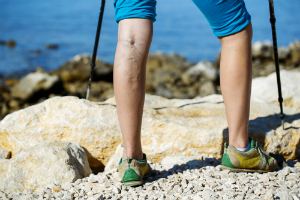Finding the best treatment for your varicose veins can be tricky, especially with all of the new treatments that have emerged in the past decade. It is hard to know what is a new fad and what is a safe medical treatment. We are here to break the stigma and let you know what might be best for treating your venous condition(s).
In the majority of varicose vein cases, we treat the veins using laser assisted saphenous endoablation (LASE). We have also used the Venefit (Radiofrequency) Closure. Both procedures are minimally invasive, very safe and extremely effective.
Our LASE treatment has been used in our clinic for 12 years to treat large varicose veins. The procedure involves a small incision to create access to the vein. A small, thin laser fiber is inserted into the vein, guided to the site being treated and heated in order to close the vein. The fiber is then led back through the vein to complete the closure. Your blood flow back to the heart will be redirected to collateral veins that are working correctly.
LASE is typically only used to treat larger varicose veins such as the Greater Saphenous or Small Saphenous veins, and not considered for smaller veins LASE is very successful in treating large veins that may lead to more serious venous conditions like deep or superficial venous thrombosis.
Our patient’s that have one of the these two procedures are able to walk and drive themselves home immediately after surgery. Occasionally a patient may need one additional day off of work.
Sclerotherapy vs Surface Laser treatment of Spider and Reticular Veins
Sclerotherapy is very different from a LASE treatment, in that it is administered through an injection using very small needles about the size of a strand of hair. Schlerotherapy is used to treat reticular or spider veins.
Reticular veins are not as large or prominent as varicose veins, but do have a bluish green color and are visible from the surface of the skin and lay just under the dermis. Reticular and spider veins are treated using sclerosant solutions such as: Glycerin, Aethoxysklerol, Polidocanol, Sotradecol. Which one is used will be determined by your physician. This treatment is minimally invasive and carries no associated pain.
Spider veins, or the small clusters of veins that are usually red, blue or purple and typically show up on the face and legs. These small veins are in the skin. Some of the solutions used to treat reticular veins are used to treat spider veins. These veins are too small to require the use of laser ablation or more invasive procedures. A surface laser can be used to treat spider veins. Usually a laser technician performs these procedures. It is not the Gold Standard and is usually saved for facial spider veins and not on the legs. The cost is great and the treatment tends to be more painful.
Your Options
When choosing a treatment for your venous condition, it is important to undergo an initial screening with your physician before deciding which treatment is best. After a diagnostic ultrasound, you and your doctor can better determine where your problem begins (the greatest source of pressure), whether it is serious and requires immediate attention and how to approach treatment.
When you choose treatment with Coastal Plains Surgical Care, you are provided high-quality care and expert treatment by Dr. Schlotter. He has dedicated his practice to treating venous disease, as it is his true passion in the medical field. His precision in his treatments and the special care he takes with each of his patients has earned him a spectacular reputation throughout Beeville. His past patients are always willing to brag about how much they love being a part of the Coastal Plains family.
To schedule your next appointment, call (361) 354-2832.

